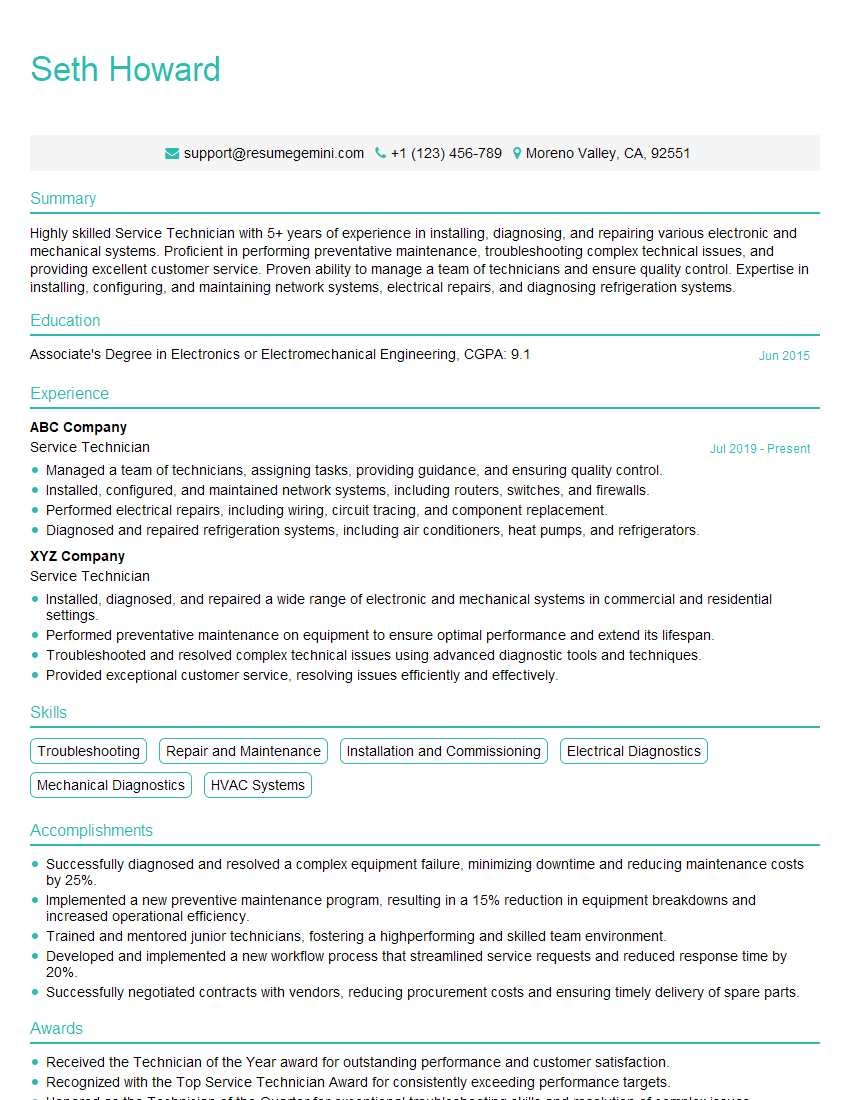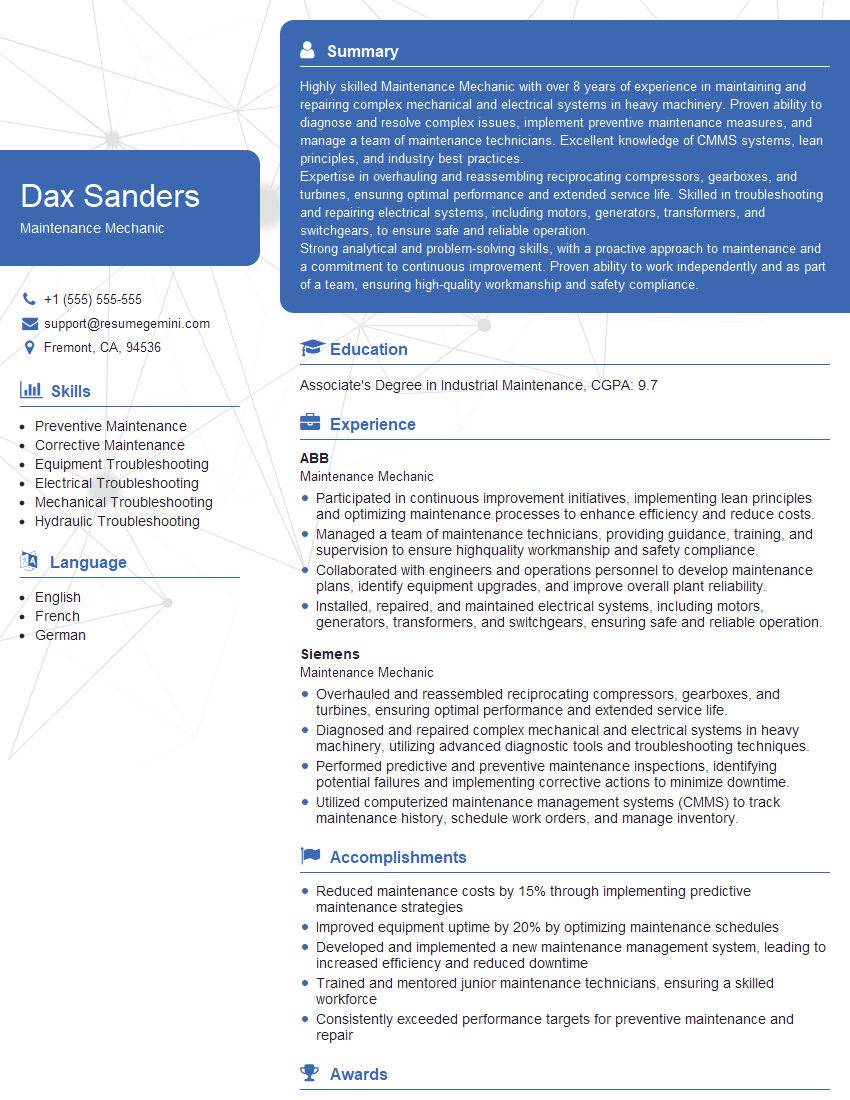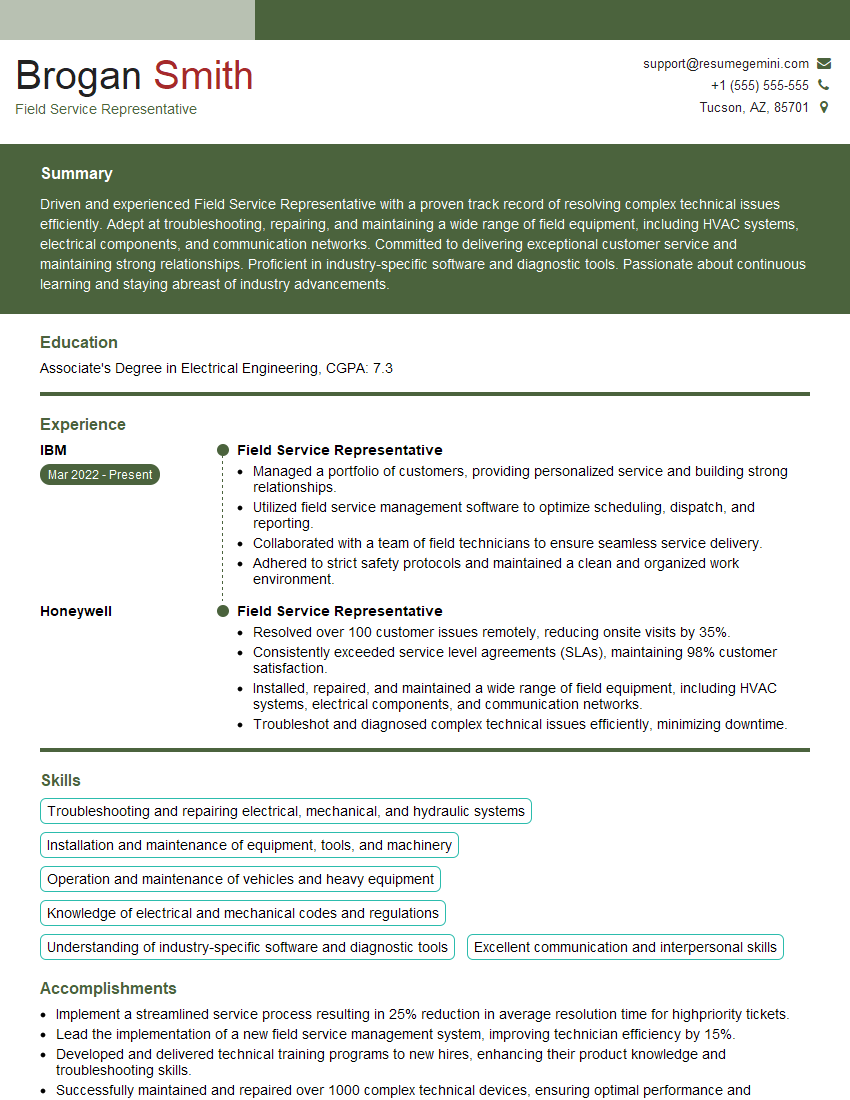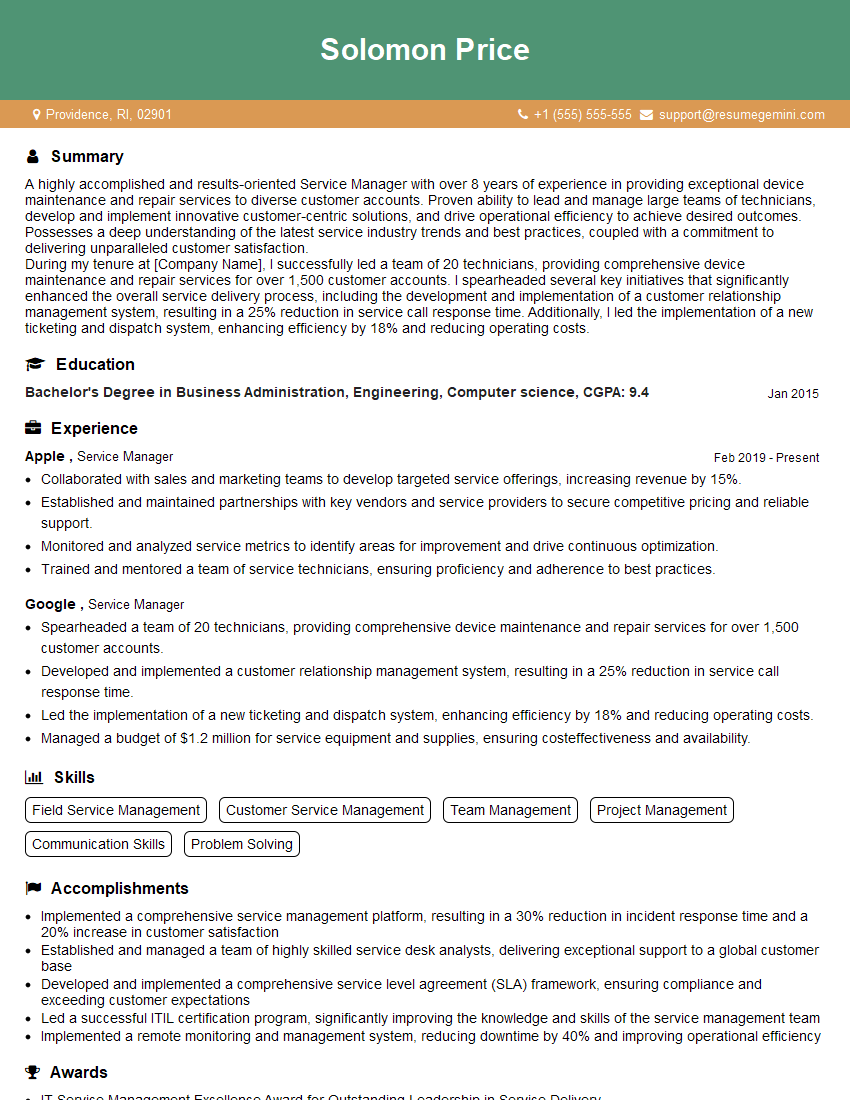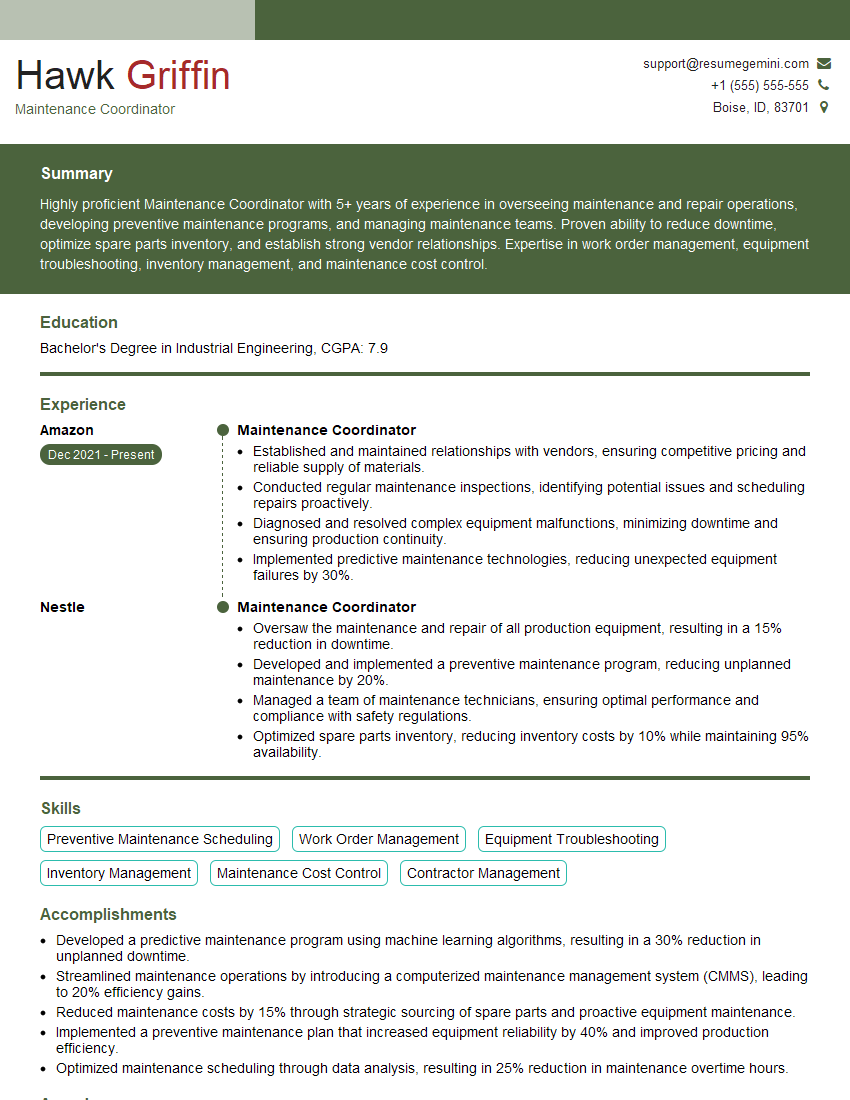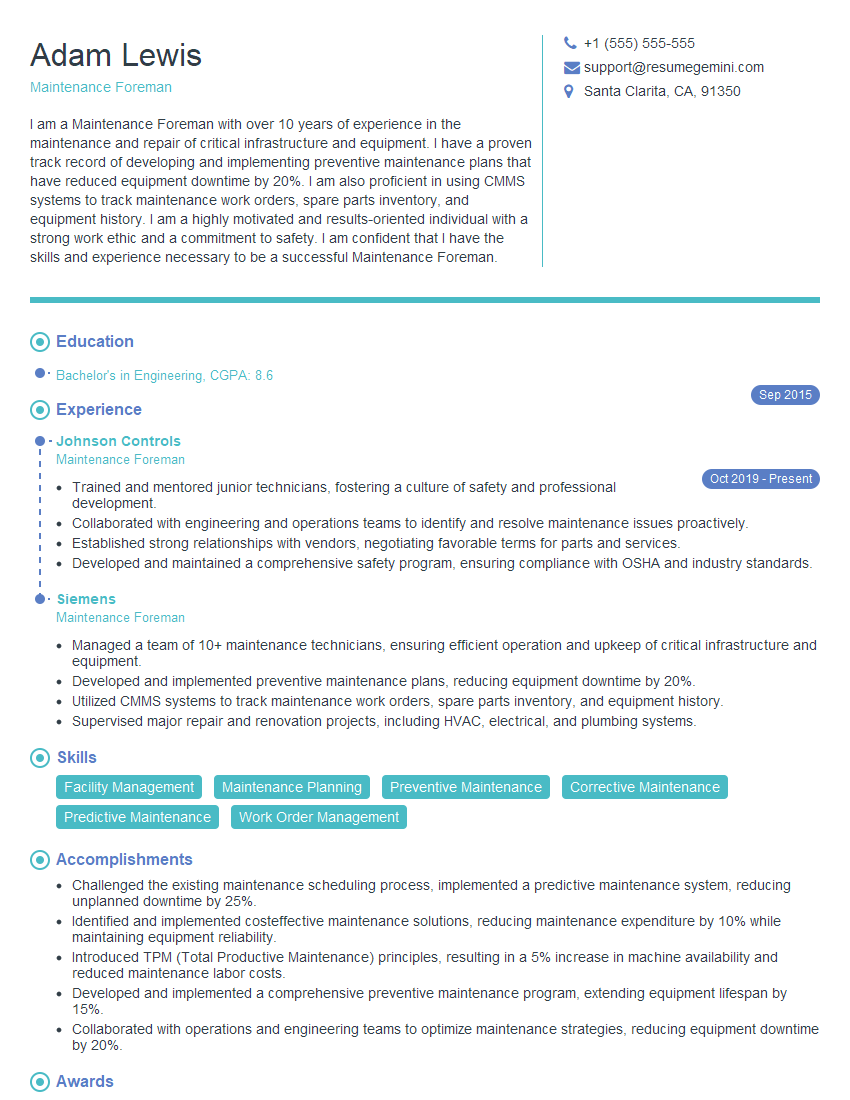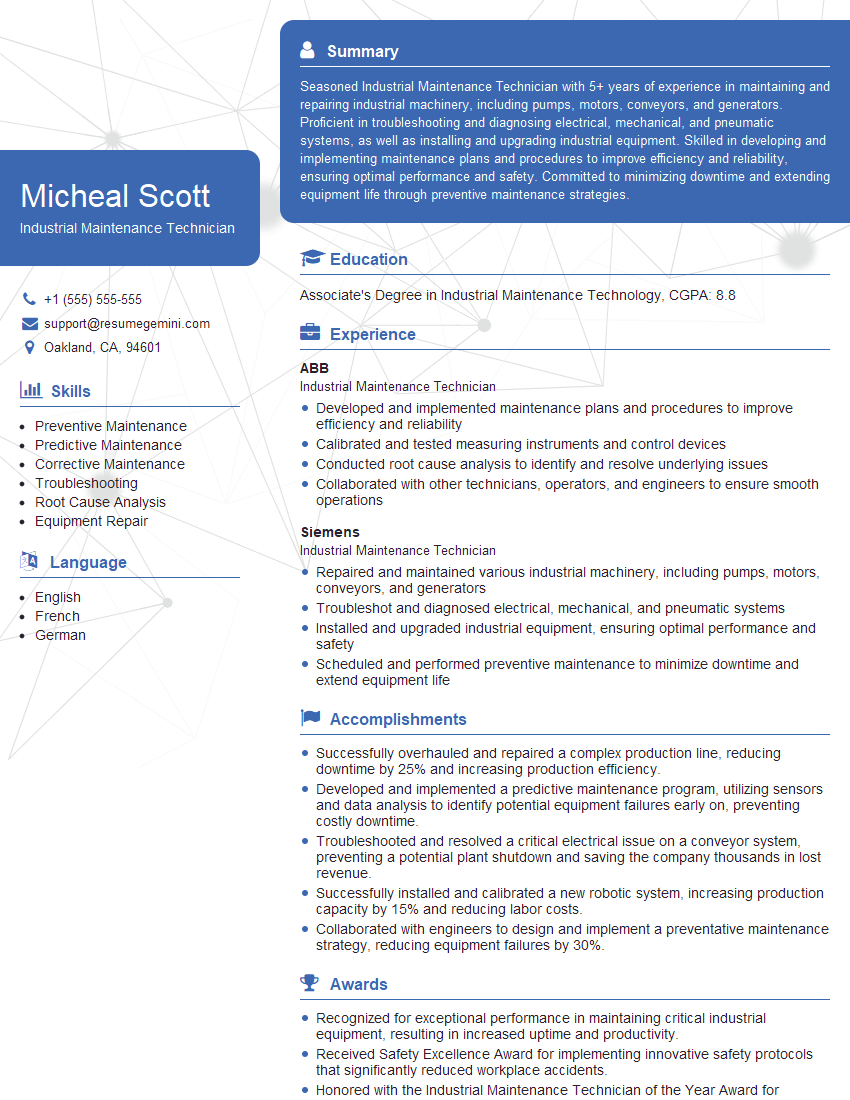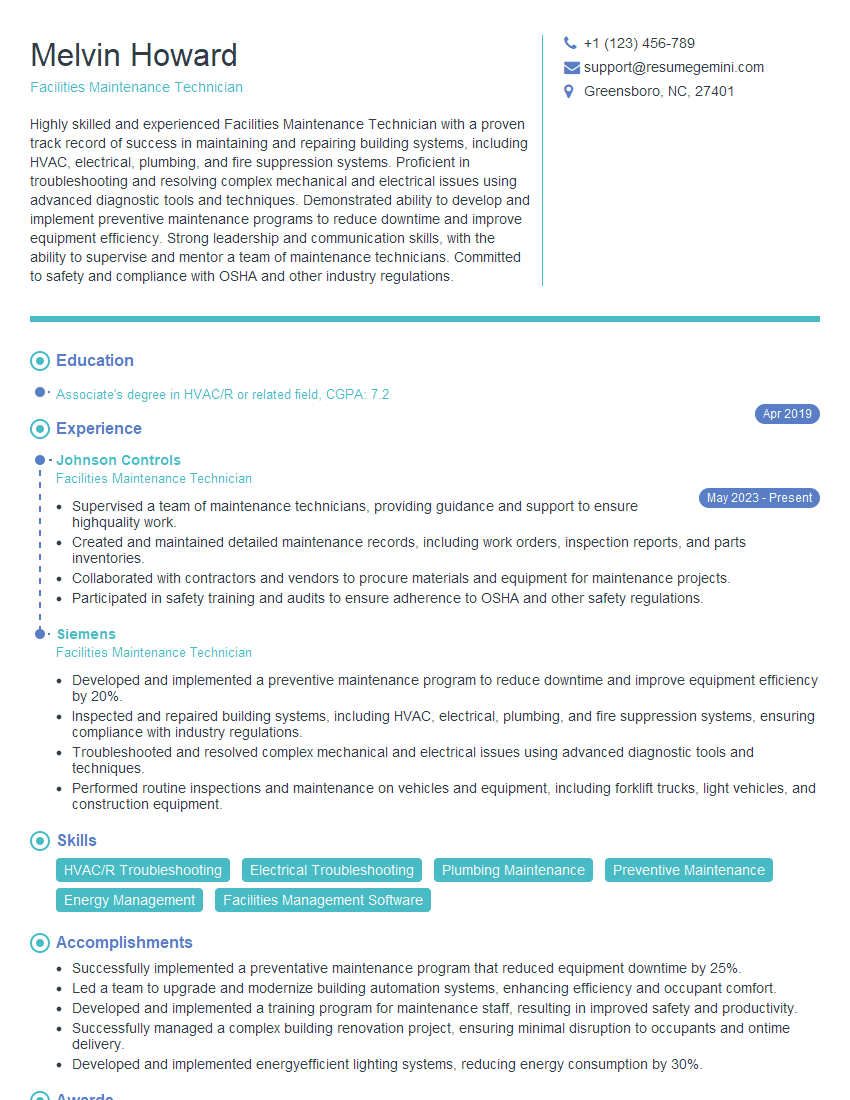Feeling uncertain about what to expect in your upcoming interview? We’ve got you covered! This blog highlights the most important Preventive Maintenance and Service interview questions and provides actionable advice to help you stand out as the ideal candidate. Let’s pave the way for your success.
Questions Asked in Preventive Maintenance and Service Interview
Q 1. Explain the importance of preventive maintenance.
Preventive maintenance (PM) is proactive maintenance performed on equipment or systems to prevent failures and reduce downtime. Think of it like regular check-ups for your car – you don’t wait for it to break down completely; you schedule oil changes, tire rotations, and other routine services to keep it running smoothly. This is crucial for several reasons:
- Increased Equipment Lifespan: Regularly scheduled PM extends the useful life of assets by catching potential problems early, preventing major failures and costly repairs.
- Reduced Downtime: By identifying and addressing minor issues before they escalate, PM significantly minimizes unexpected downtime and production disruptions.
- Improved Safety: Regular inspections and maintenance identify potential safety hazards, reducing the risk of accidents and injuries to personnel.
- Lower Maintenance Costs: Addressing small issues proactively is far less expensive than dealing with major breakdowns and emergency repairs. Preventative maintenance saves money in the long run.
- Enhanced Efficiency: Well-maintained equipment operates more efficiently, producing higher quality products with less waste.
For example, in a manufacturing plant, regular lubrication of machinery prevents wear and tear, ensuring consistent production output. Ignoring this can lead to costly breakdowns, halting the entire production line.
Q 2. Describe your experience with CMMS software (e.g., SAP PM, Maximo).
I have extensive experience utilizing Computerized Maintenance Management Systems (CMMS) software, specifically SAP PM and IBM Maximo. My experience encompasses all aspects of these systems, from data entry and work order management to reporting and analysis. In my previous role, I was responsible for:
- Work Order Creation and Scheduling: Using the CMMS to create, assign, and schedule preventative maintenance tasks based on equipment criticality and manufacturer recommendations.
- Inventory Management: Tracking spare parts and ensuring sufficient inventory levels to support maintenance activities, minimizing delays caused by parts shortages.
- Data Analysis and Reporting: Generating reports on maintenance costs, downtime, and equipment performance to identify areas for improvement and optimize maintenance strategies.
- System Configuration and Customization: Working with the IT department to configure and customize the CMMS to meet our specific needs and workflows.
- Training and Support: Training maintenance technicians on the effective use of the CMMS.
For instance, using SAP PM, I developed a customized dashboard to visualize key performance indicators (KPIs) for our maintenance operations, allowing for proactive identification of potential problems and faster decision-making. This greatly improved our maintenance efficiency and reduced downtime.
Q 3. How do you prioritize maintenance tasks?
Prioritizing maintenance tasks requires a structured approach. I typically use a combination of methods, including:
- Criticality Analysis: Assessing the criticality of equipment based on its impact on production. Equipment critical to the main production process takes precedence.
- Risk Assessment: Identifying potential risks associated with equipment failure and prioritizing maintenance based on the severity and likelihood of these risks. This often uses a risk matrix.
- Cost-Benefit Analysis: Evaluating the cost of maintenance versus the cost of equipment failure. This helps in prioritizing tasks that offer the highest return on investment.
- Manufacturer Recommendations: Following manufacturer’s recommended maintenance schedules for optimal equipment performance and lifespan.
- Age and Condition of Equipment: Older or frequently used equipment may require more frequent maintenance.
For example, a broken conveyor belt in a packaging plant would be prioritized over a minor issue with a lighting fixture, as the conveyor is critical to the production process and its failure would cause significant downtime.
Q 4. What are the key performance indicators (KPIs) you use to measure maintenance effectiveness?
Several key performance indicators (KPIs) are crucial for measuring maintenance effectiveness. Some of the most important include:
- Mean Time Between Failures (MTBF): The average time between equipment failures. A higher MTBF indicates improved reliability and effectiveness of maintenance strategies.
- Mean Time To Repair (MTTR): The average time it takes to repair failed equipment. Lower MTTR signifies efficient repair processes.
- Maintenance Costs as a Percentage of Total Operating Costs: Tracking this helps assess the cost-effectiveness of maintenance programs.
- Equipment Uptime: The percentage of time equipment is operational. High uptime is a direct indicator of effective preventative maintenance.
- Number of Preventative Maintenance Tasks Completed: Tracking this ensures that planned maintenance is consistently performed.
- Safety Incident Rate: Monitoring incidents related to maintenance activities helps measure effectiveness of safety programs.
By tracking these KPIs, I can identify trends, make data-driven decisions to improve maintenance efficiency, and demonstrate the overall return on investment of the maintenance program.
Q 5. Explain your approach to troubleshooting equipment malfunctions.
My approach to troubleshooting equipment malfunctions is systematic and methodical. I follow a structured process:
- Gather Information: Start by gathering information about the malfunction. This includes the symptoms, when the problem occurred, and any relevant operational data. Often speaking to the operators who encountered the issue can be very insightful.
- Visual Inspection: Visually inspect the equipment for any obvious signs of damage or malfunction. Check for loose connections, worn parts, or leaks.
- Systematic Testing: Utilize test equipment (multimeters, oscilloscopes, etc.) to diagnose the problem. Work through a logical process of elimination, testing individual components or circuits.
- Consult Documentation: Refer to technical manuals, schematics, and previous maintenance records for troubleshooting guidance.
- Escalation: If the problem cannot be solved, escalate the issue to a more experienced technician or engineer.
For example, if a motor fails to start, I would first check the power supply, then the motor windings using a multimeter, before investigating more complex issues within the motor control circuit.
Q 6. Describe a time you had to work under pressure to resolve a maintenance issue.
In a previous role, we experienced a major breakdown of a critical piece of production equipment during a peak season. The failure threatened to severely impact our production schedule and meet customer deadlines. Under immense pressure, I immediately assembled a team, coordinated the procurement of necessary parts, and implemented a plan to repair the equipment as quickly as possible.
We worked around the clock, implementing a temporary workaround to minimize the production disruption while simultaneously addressing the root cause of the failure. This involved detailed analysis, careful coordination of several skilled technicians, and prioritizing tasks strategically. We successfully repaired the equipment within 48 hours, minimizing production losses and preventing major financial repercussions. This experience highlighted the importance of a strong team, clear communication, and effective problem-solving under pressure.
Q 7. How do you ensure compliance with safety regulations during maintenance activities?
Ensuring compliance with safety regulations is paramount in all maintenance activities. My approach includes:
- Lockout/Tagout (LOTO) Procedures: Strictly adhering to LOTO procedures to prevent accidental energization of equipment during maintenance work. This is crucial to prevent injuries.
- Personal Protective Equipment (PPE): Ensuring that all maintenance personnel use appropriate PPE, such as safety glasses, gloves, hearing protection, and safety shoes, according to the specific task.
- Risk Assessments: Conducting thorough risk assessments before commencing any maintenance activity to identify and mitigate potential hazards.
- Training and Education: Providing regular training to maintenance personnel on safety procedures, hazard recognition, and the correct use of PPE.
- Compliance Audits: Regularly conducting compliance audits to ensure adherence to safety regulations and identify areas for improvement.
- Reporting and Documentation: Maintaining accurate records of all safety incidents and corrective actions to prevent recurrence.
Safety is not just a procedure; it’s a culture. We foster a proactive safety culture where everyone feels responsible for identifying and addressing safety concerns.
Q 8. What types of maintenance strategies are you familiar with (e.g., predictive, preventive, corrective)?
There are several maintenance strategies, each with its own approach to minimizing downtime and maximizing equipment lifespan. Corrective maintenance is reactive; it addresses equipment issues only after they occur. Preventive maintenance is proactive, aiming to prevent failures through scheduled inspections and servicing. Predictive maintenance utilizes data analysis (e.g., vibration analysis, oil analysis) to predict potential failures and schedule interventions accordingly. Finally, run-to-failure, though often risky, involves operating equipment until failure, then performing corrective maintenance. I’m proficient in all these strategies, but I find preventive and predictive maintenance to be the most effective in the long run, minimizing unexpected downtime and maximizing equipment lifespan.
- Corrective: Think of this as fixing a flat tire only after you’ve gotten a flat. It’s reactive and disrupts operations.
- Preventive: Like regularly rotating your car’s tires to extend their lifespan and avoid a sudden blowout. Proactive and planned.
- Predictive: Using tire pressure sensors to monitor tire condition and predict potential problems before they become critical. Data-driven and efficient.
- Run-to-Failure: This is analogous to driving your car until it completely breaks down, which can be expensive and inconvenient.
Q 9. Explain your understanding of Root Cause Analysis (RCA).
Root Cause Analysis (RCA) is a systematic process for identifying the underlying causes of problems, rather than just addressing symptoms. It’s crucial for preventing recurrence. I typically use a combination of techniques, including the ‘5 Whys’ method, fault tree analysis, and fishbone diagrams. The goal isn’t just to fix the immediate issue, but to unearth the root problem. For example, if a machine overheats, simply replacing a faulty component might only be a temporary fix. A thorough RCA might reveal inadequate cooling systems, faulty operator training, or even a design flaw.
Let’s say a conveyor belt keeps breaking down. The ‘5 Whys’ method would involve asking ‘why’ repeatedly:
- Why did the conveyor belt break? Because the belt slipped.
- Why did the belt slip? Because the rollers were worn.
- Why were the rollers worn? Because they weren’t lubricated properly.
- Why weren’t they lubricated? Because the lubrication schedule wasn’t being followed.
- Why wasn’t the schedule followed? Because of inadequate training for maintenance staff.
The root cause isn’t the slipped belt, it’s inadequate training. Addressing this ultimately prevents future breakdowns.
Q 10. How do you develop and maintain a preventive maintenance schedule?
Developing a preventive maintenance schedule involves a careful process. First, I assess all equipment, noting its criticality, operational hours, manufacturer recommendations, and historical failure data. This creates a prioritized list for scheduling. The schedule considers factors like frequency (daily, weekly, monthly, annually), tasks to be performed (inspections, lubrication, replacements), and resource allocation (personnel, parts). I use CMMS (Computerized Maintenance Management System) software to manage schedules and track performance, generating reports to identify trends and areas for improvement. This schedule is regularly reviewed and adjusted based on equipment performance and new insights gathered from data analysis.
For example, a critical piece of equipment might need daily lubrication checks while a less critical piece might only require a monthly inspection. I ensure the schedule is comprehensive and accounts for all necessary maintenance activities, aiming for a balance between minimizing downtime and maintaining cost-effectiveness.
Q 11. Describe your experience with different types of maintenance documentation.
I have extensive experience with various maintenance documentation types. These include:
- Preventive Maintenance Schedules: Detailed calendars outlining tasks, frequencies, and responsible personnel.
- Work Orders: Records of maintenance tasks performed, including details of work done, materials used, and time taken.
- Maintenance Logs: A chronological record of all maintenance activities, including repairs, inspections, and part replacements.
- Equipment History Records: Comprehensive files detailing equipment specifications, performance history, and maintenance history. This aids in predictive maintenance.
- Spare Parts Inventories: Lists of all spare parts, their locations, and quantities. This ensures parts availability when needed.
- Inspection Reports: Documenting results of regular equipment inspections, flagging potential issues.
Proper documentation is essential for tracking performance, complying with regulations, and improving future maintenance strategies. I ensure all documentation is accurate, complete, and easily accessible. Utilizing a CMMS software is key in managing and centralizing this information.
Q 12. How do you manage spare parts inventory for maintenance activities?
Managing spare parts inventory is crucial for minimizing downtime. I employ a combination of techniques, including ABC analysis (categorizing parts based on value and usage), just-in-time (JIT) inventory management, and using CMMS software to track stock levels and generate re-order points. ABC analysis helps prioritize high-value, critical parts. JIT inventory minimizes storage costs by ordering parts only when needed. The CMMS software provides real-time visibility into inventory levels, alerts me when levels are low, and assists in automating reordering. Regular audits and cycle counts ensure accuracy and help identify obsolete or excess parts.
For instance, high-value, critical components of a production line would be closely monitored using JIT and frequent inventory checks. Less critical parts might be managed with a more relaxed approach, based on a fixed re-order point.
Q 13. What are some common causes of equipment failure and how can they be prevented?
Equipment failure has many causes, often stemming from a combination of factors. Some common causes include:
- Lack of lubrication: Friction and wear lead to component failure. Preventive measures include regular lubrication schedules.
- Improper operation: Operator errors can cause damage. Proper training and clear procedures are crucial.
- Normal wear and tear: Components degrade over time. Regular inspections and replacements according to the schedule prevent catastrophic failure.
- Environmental factors: Extreme temperatures, humidity, or dust can negatively impact equipment. Protective measures, such as enclosures or climate control, are often necessary.
- Insufficient maintenance: Neglecting preventive maintenance increases the risk of failures. A robust maintenance program is critical.
- Design flaws: Inherent weaknesses in the equipment’s design can predispose it to failure. Design improvements should be identified and implemented through RCA.
Preventive measures include regular inspections, lubrication, cleaning, and following manufacturer recommendations for maintenance. This proactive approach significantly reduces the likelihood of failure and increases equipment lifespan.
Q 14. How do you handle unexpected equipment failures?
Unexpected equipment failures require immediate attention. My approach involves a structured process:
- Assess the situation: Determine the severity of the failure and its impact on operations.
- Implement immediate corrective actions: If safe to do so, I take steps to mitigate further damage or prevent escalation (e.g., shut down the equipment). If not, secure the area to prevent accidents.
- Notify relevant personnel: Inform supervisors, maintenance teams, and potentially clients, depending on the impact.
- Conduct a thorough RCA: Once the immediate issue is addressed, I initiate RCA to understand the root cause and prevent recurrence.
- Implement repairs or replacements: Make the necessary repairs or replace faulty components.
- Document the incident: Record all relevant details in the maintenance logs, including the cause, actions taken, and time to resolution. This data will inform future preventive maintenance strategies.
I prioritize safety and minimize downtime. A well-defined emergency procedure ensures efficient and effective responses to unexpected breakdowns.
Q 15. Explain your experience with various maintenance tools and equipment.
My experience with maintenance tools and equipment is extensive, encompassing both traditional and advanced technologies. I’m proficient in using a wide range of hand tools, from basic wrenches and screwdrivers to specialized torque wrenches and precision measuring instruments. I’m also experienced with power tools such as grinders, drills, and impact wrenches, always adhering to safety protocols. Beyond hand and power tools, I’m familiar with diagnostic equipment like multimeters, thermal cameras, and vibration analyzers. For instance, in a recent project involving a malfunctioning conveyor belt, I used a thermal camera to pinpoint an overheating motor bearing, preventing a catastrophic failure. My experience also extends to using Computerized Maintenance Management Systems (CMMS) software for managing work orders, inventory, and maintenance schedules. I’m comfortable using various CMMS platforms such as SAP PM and Maximo, allowing for efficient data management and reporting.
Furthermore, I have experience operating and maintaining specialized equipment relevant to the specific industry. For example, in my previous role at a manufacturing plant, I was responsible for maintaining hydraulic presses and CNC machines, requiring a thorough understanding of their mechanical and electrical systems.
Career Expert Tips:
- Ace those interviews! Prepare effectively by reviewing the Top 50 Most Common Interview Questions on ResumeGemini.
- Navigate your job search with confidence! Explore a wide range of Career Tips on ResumeGemini. Learn about common challenges and recommendations to overcome them.
- Craft the perfect resume! Master the Art of Resume Writing with ResumeGemini’s guide. Showcase your unique qualifications and achievements effectively.
- Don’t miss out on holiday savings! Build your dream resume with ResumeGemini’s ATS optimized templates.
Q 16. How do you communicate effectively with other technicians and management regarding maintenance issues?
Effective communication is paramount in a maintenance environment. I prioritize clear and concise communication, both verbally and in writing. With technicians, I use plain language, focusing on the specific issue, proposed solution, and any potential safety concerns. I actively listen to their input and value their expertise, fostering a collaborative atmosphere. For instance, when troubleshooting a complex electrical fault, I involved the electricians in a brainstorming session, resulting in a faster, more effective solution than I could have achieved alone.
When communicating with management, I focus on providing clear, data-driven updates on maintenance activities, including progress, challenges, and cost implications. I use reports and presentations to highlight key performance indicators (KPIs) such as equipment uptime and maintenance costs, ensuring transparency and accountability. For example, I prepared a cost-benefit analysis report demonstrating the advantages of implementing a predictive maintenance program, resulting in budget approval for new equipment purchases. I believe in proactive communication, alerting management to potential issues before they escalate into costly downtime.
Q 17. Describe your experience working with various types of machinery.
My experience spans a wide range of machinery, including rotating equipment (motors, pumps, compressors), conveying systems (belts, conveyors), HVAC systems, and various types of processing equipment specific to different industries. In my previous role, I maintained large-scale industrial machinery used in food processing, involving complex automated systems and precise calibration requirements. This experience required a deep understanding of both mechanical and electrical systems, as well as safety protocols specific to food-grade equipment. I’m also experienced with smaller scale machinery commonly found in manufacturing environments, such as lathes, milling machines and robotic arms. I always prioritize safety procedures and follow all relevant regulations when working with any machinery.
Beyond specific machinery types, my experience lies in understanding the underlying principles of mechanical systems, making it easier to learn and adapt to new equipment. This transferable skill allows me to approach any new machinery with a methodical diagnostic process.
Q 18. How do you ensure the accuracy of maintenance records?
Accuracy in maintenance records is crucial for tracking equipment history, predicting future needs, and ensuring regulatory compliance. I maintain meticulous records, using a CMMS system to document all maintenance activities, including work orders, spare parts used, labor hours, and any relevant observations. I ensure all information is accurate and complete, including details of the problem, the solution implemented, and the outcome. I regularly review and audit my own records for any inconsistencies and promptly rectify any errors. For example, I utilize check lists to ensure a consistent and thorough process across all maintenance activities.
Furthermore, I also enforce a system of checks and balances. This could include having another technician verify critical data entries or using automated data validation features in the CMMS. This helps in identifying and correcting errors early, improving data integrity and ultimately leading to better decision-making.
Q 19. What is your experience with predictive maintenance techniques (e.g., vibration analysis, oil analysis)?
I have significant experience with predictive maintenance techniques, focusing on preventing equipment failures rather than simply reacting to them. This includes vibration analysis, oil analysis, and thermal imaging. Vibration analysis helps identify imbalances, misalignments, or bearing defects in rotating equipment. I use handheld vibration analyzers to collect data and interpret the results, using frequency spectra to pinpoint the root cause of the problem. Oil analysis involves testing lubricating oil for contamination, wear particles, and degradation products, indicating potential issues with machinery. For example, an increase in iron particles in the oil sample can indicate bearing wear.
Thermal imaging allows for the detection of overheating components, which could be a symptom of electrical faults, friction, or other mechanical problems. By using this data, I can schedule proactive maintenance before problems escalate, reducing downtime and preventing costly repairs. I’m proficient in interpreting the results from these analyses and translating them into actionable maintenance plans. I’ve seen firsthand how these predictive techniques drastically reduce unplanned downtime and extend the lifespan of machinery.
Q 20. How do you stay up-to-date with the latest technologies and best practices in maintenance?
Staying current with the latest technologies and best practices in preventive maintenance is crucial in this ever-evolving field. I actively participate in professional development activities such as attending industry conferences, workshops, and online courses. I regularly read industry publications, such as journals and technical blogs, and participate in online forums to stay abreast of new developments. I also actively seek out and engage with industry experts through networking opportunities.
Furthermore, I’m always eager to learn and experiment with new technologies. This includes implementing new CMMS features, experimenting with data analytics to predict maintenance needs, and exploring new sensor technologies and diagnostic software. Continuous learning helps to enhance my expertise and provide efficient and cost-effective maintenance solutions.
Q 21. Describe your experience with cost-benefit analysis of maintenance projects.
Cost-benefit analysis is critical for making informed decisions about maintenance projects. I’m experienced in evaluating the costs and benefits of different maintenance strategies, including preventive, predictive, and corrective maintenance. For example, when proposing a new predictive maintenance program, I would carefully consider the costs of implementing the program – including the investment in new equipment, training, and software licenses – against the expected benefits, such as reduced downtime, lower repair costs, and extended equipment lifespan. I use various financial modeling techniques to project cost savings and return on investment (ROI). I would also consider intangible benefits such as improved safety and environmental protection.
I present my findings clearly and concisely to management, using data-driven arguments to support my recommendations. I understand that not all maintenance projects justify the investment, and I’m adept at identifying those instances and recommending more cost-effective approaches. This helps make optimal allocation of resources, ensuring cost-effectiveness and maximum return on investment for the organization.
Q 22. How do you identify and assess maintenance risks?
Identifying and assessing maintenance risks involves a systematic approach that combines proactive hazard identification with a thorough risk evaluation. It’s like being a detective for potential equipment failures.
- Failure Modes and Effects Analysis (FMEA): This technique helps systematically identify potential failure modes in equipment, their causes, and their effects on the overall system. For example, in a manufacturing plant, we might use FMEA to analyze a conveyor belt, identifying potential failures like belt slippage, motor burnout, or sensor malfunction, and assessing the severity and likelihood of each.
- Root Cause Analysis (RCA): When a failure occurs, RCA helps us understand the underlying causes, preventing future occurrences. For instance, if a pump fails, RCA might reveal issues with lubrication, overloading, or improper installation.
- Preventive Maintenance Schedules: Regularly scheduled maintenance reduces the risk of unexpected failures. By reviewing historical maintenance data and equipment specifications, we determine the optimal frequency for inspections, lubrication, and component replacements.
- Visual Inspections and Audits: Regular visual checks and comprehensive audits help detect early signs of wear and tear or potential problems before they escalate into major failures. Think of it as a regular health checkup for your equipment.
- Risk Matrices: These matrices help visually represent the risk level associated with different failure modes based on their likelihood and severity. This allows prioritization of maintenance tasks based on risk level.
By combining these methods, we create a comprehensive risk assessment that guides our preventive maintenance strategy and resource allocation.
Q 23. What is your experience with developing and implementing maintenance procedures?
Developing and implementing maintenance procedures requires a structured approach, ensuring clarity, consistency, and effectiveness. I’ve been involved in several projects where I’ve successfully implemented maintenance procedures using a phased approach.
- Procedure Development: I begin by gathering information from equipment manuals, engineering specifications, and past maintenance records. Then, I create detailed step-by-step procedures, including safety precautions, tools required, and acceptance criteria. For instance, when developing a procedure for replacing a motor bearing, I would specify the exact bearing type, torque values for the fasteners, and the necessary safety equipment like eye protection and lockout/tagout devices.
- Procedure Validation: Before implementing new procedures, I conduct thorough testing and validation. This might involve pilot testing the procedures on similar equipment, documenting the results, and making adjustments as needed. Feedback from maintenance personnel is crucial during this phase.
- Documentation and Training: I ensure all procedures are clearly documented and easily accessible to maintenance personnel. This includes diagrams, photographs, and clear language. This is accompanied by comprehensive training to ensure everyone understands the procedure.
- Software Integration: Where applicable, procedures are integrated into Computerized Maintenance Management Systems (CMMS) software for automated scheduling, tracking, and reporting. This aids in better management and efficiency.
Through this systematic process, I ensure that maintenance procedures are clear, safe, efficient, and contribute to a reduction in equipment downtime and improved overall reliability.
Q 24. Explain your experience with training other maintenance personnel.
Training maintenance personnel is a crucial aspect of a successful maintenance program. I approach training with a blended learning strategy, combining classroom instruction with hands-on practical experience.
- Needs Assessment: I begin by assessing the training needs of each individual or group. This involves identifying skill gaps and knowledge deficiencies. This is done through interviews, performance reviews, and observation.
- Curriculum Development: I develop a training curriculum that addresses specific skill gaps. The curriculum includes both theoretical concepts and practical application. For example, I might design a module on hydraulic systems that combines classroom instruction on the principles of hydraulics with hands-on practice using a hydraulic training rig.
- Delivery Methods: I utilize various delivery methods, including classroom lectures, demonstrations, hands-on training, and simulations. The choice of method depends on the specific skill being taught and the learning styles of the trainees.
- Assessment and Feedback: Training is followed by assessment to measure learning effectiveness. This might involve written tests, practical exercises, and observation of performance on the job. Feedback is provided to the trainees to identify areas for improvement.
- Mentorship and On-the-Job Training: I often implement mentoring programs where experienced technicians guide newer members, fostering practical skill development in a real-world setting.
My focus is always on building competence and confidence among maintenance personnel, which directly contributes to a safer and more efficient work environment.
Q 25. How do you ensure the effectiveness of your maintenance program?
Ensuring the effectiveness of a maintenance program involves continuous monitoring, evaluation, and improvement. It’s an ongoing process, not a one-time task.
- Key Performance Indicators (KPIs): I track KPIs like Mean Time Between Failures (MTBF), Mean Time To Repair (MTTR), equipment uptime, maintenance costs, and safety incidents. These KPIs provide objective measures of the program’s effectiveness.
- Regular Reporting and Analysis: Regular reports are generated and analyzed to identify trends and areas for improvement. For example, a consistent increase in MTTR for a particular piece of equipment might indicate a need for improved training or a redesign of the maintenance procedure.
- Audits and Inspections: Regular audits and inspections of maintenance practices help identify deviations from established procedures and opportunities for improvement. This ensures compliance with safety regulations and best practices.
- Continuous Improvement: The program is continuously improved based on data analysis, feedback from maintenance personnel, and industry best practices. This might involve updating maintenance procedures, implementing new technologies, or providing additional training.
- Feedback Mechanisms: Open communication channels are established to gather feedback from maintenance personnel, operators, and other stakeholders. This helps identify issues and potential improvements quickly.
By systematically monitoring and evaluating the program’s effectiveness, we ensure that it continues to meet the needs of the organization and contributes to the overall efficiency and reliability of its operations.
Q 26. How do you manage maintenance budgets?
Managing maintenance budgets requires careful planning, resource allocation, and continuous monitoring. I utilize a multi-faceted approach to ensure cost-effectiveness without compromising reliability.
- Budget Development: The budget is developed based on a thorough assessment of equipment needs, maintenance requirements, and historical cost data. This includes forecasting material costs, labor costs, and contract costs.
- Prioritization of Tasks: Maintenance tasks are prioritized based on their criticality and risk level. This ensures that resources are allocated to the most important tasks first. We might use a risk matrix to help prioritize tasks.
- Cost Control Measures: Various cost control measures are implemented to ensure that the budget is managed effectively. This includes negotiating favorable contracts with vendors, optimizing inventory levels, and implementing preventive maintenance programs to reduce the need for reactive repairs.
- Performance Monitoring: The budget is monitored regularly to ensure that expenditures align with the plan. Any deviations from the budget are investigated, and corrective actions are taken as needed.
- Continuous Improvement: The budget process is continuously improved based on historical data and feedback from stakeholders. This helps to refine forecasting and resource allocation in subsequent periods.
By combining detailed planning, continuous monitoring, and proactive cost-control measures, I can effectively manage maintenance budgets, ensuring that resources are utilized efficiently and effectively.
Q 27. What are your strengths and weaknesses in a maintenance environment?
In a maintenance environment, my strengths lie in my methodical approach to problem-solving, my ability to effectively lead and train teams, and my commitment to continuous improvement.
- Strengths: I excel at systematically diagnosing and resolving equipment failures, developing and implementing effective maintenance procedures, and training and mentoring maintenance personnel. My experience with CMMS systems and data analysis allows for informed decision-making and proactive maintenance planning.
- Weaknesses: While I’m adept at technical troubleshooting, I sometimes struggle with delegating tasks, especially when dealing with complex or critical issues. I’m actively working to improve my delegation skills by fostering a more collaborative and trusting team environment.
I am always striving to improve my skills, especially in areas where I identify weaknesses. I recognize that continuous professional development is crucial in this dynamic field.
Q 28. Describe your experience with contract maintenance management.
My experience with contract maintenance management encompasses all aspects from contract negotiation to performance monitoring and evaluation. It’s about finding the right balance between cost and reliability.
- Contract Negotiation: I’ve negotiated numerous contracts with external maintenance providers, ensuring that contracts are comprehensive, clearly defined, and align with the organization’s needs and budget. This includes specifying service levels, response times, and reporting requirements.
- Vendor Selection: I’ve been involved in selecting suitable vendors based on their experience, qualifications, and financial stability. A thorough vendor evaluation process is always implemented before awarding contracts.
- Performance Monitoring: I closely monitor the performance of external maintenance providers, ensuring that they meet the agreed-upon service levels and reporting requirements. This often involves regular performance reviews and feedback sessions.
- Contract Management: I’m adept at managing the entire lifecycle of maintenance contracts, from initiation to termination, ensuring compliance with contractual obligations and resolving any disputes that may arise.
- Cost Optimization: I constantly seek ways to optimize the cost of contract maintenance while ensuring high-quality service. This might involve renegotiating contract terms, exploring alternative providers, or implementing changes to maintenance procedures.
My goal is to ensure that contracted maintenance services are delivered efficiently, cost-effectively, and in a manner that supports the organization’s operational objectives.
Key Topics to Learn for Preventive Maintenance and Service Interview
- Understanding Preventive Maintenance Schedules: Learn to interpret and create effective preventive maintenance schedules based on equipment specifications and operational needs. Consider factors like frequency, task specifics, and resource allocation.
- Predictive Maintenance Techniques: Explore the practical application of predictive maintenance methods such as vibration analysis, oil analysis, and thermal imaging to anticipate equipment failures and optimize maintenance strategies. Understand the data analysis involved in interpreting results.
- Maintenance Management Systems (CMMS): Familiarize yourself with the use of CMMS software for tracking maintenance activities, managing work orders, and generating reports. Understand the benefits and challenges of using such systems effectively.
- Troubleshooting and Repair Procedures: Develop a strong understanding of common equipment malfunctions and the systematic approach to troubleshooting and implementing effective repair procedures. Practice identifying root causes and preventative measures.
- Safety Regulations and Compliance: Demonstrate knowledge of relevant safety regulations and compliance standards related to preventive maintenance and service procedures. Highlight your understanding of risk assessment and mitigation.
- Inventory Management for Maintenance Parts: Understand the importance of effective inventory management for maintaining optimal stock levels of spare parts and consumables. Discuss strategies for minimizing downtime through efficient procurement and storage.
- Cost Optimization Strategies: Explore techniques for optimizing maintenance costs while maintaining equipment reliability. Discuss methods for improving efficiency and reducing waste.
- Teamwork and Communication in Maintenance: Emphasize the importance of effective communication and collaboration within a maintenance team, and with other departments. Discuss strategies for problem-solving and knowledge sharing.
Next Steps
Mastering Preventive Maintenance and Service is crucial for career advancement in many industries. A strong understanding of these concepts demonstrates valuable skills and expertise, leading to greater responsibility and higher earning potential. To maximize your job prospects, creating a compelling and ATS-friendly resume is essential. ResumeGemini is a trusted resource that can help you build a professional resume that showcases your skills and experience effectively. ResumeGemini provides examples of resumes tailored to Preventive Maintenance and Service to guide you in crafting your own stand-out application.
Explore more articles
Users Rating of Our Blogs
Share Your Experience
We value your feedback! Please rate our content and share your thoughts (optional).
What Readers Say About Our Blog
Hi, I’m Jay, we have a few potential clients that are interested in your services, thought you might be a good fit. I’d love to talk about the details, when do you have time to talk?
Best,
Jay
Founder | CEO






